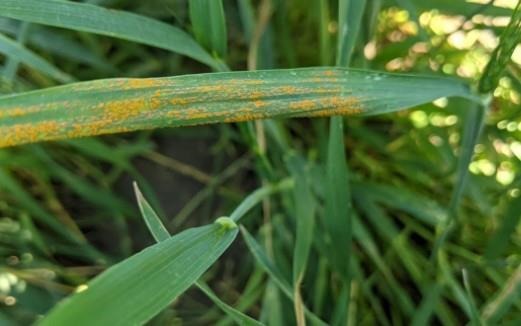By Emmanuel Byamukama
Stripe rust was found in a few winter wheat fields scouted this week. In several fields, just a few pustules on a few plants were observed. However, the presence of a few plants with stripe rust indicates there is inoculum of this pathogen in the state. Stripe rust, or yellow rust, is caused by a fungal pathogen Puccinia striiformis f. sp. Tritici, and it forms yellow-orange linear pustules (hence the name stripe) on the leaves (Figure 1). The inoculum for this pathogen is blown into the state from southern states, where the pathogen overwinters.

Figure 1. Stripe rust symptoms. Notice the yellow-orange color and pustules arranged in a linear (stripe) pattern.
Stripe rust is favored by cooler temperatures (<70 degrees Fahrenheit) and wet conditions (at least eight hours of leaf wetness). Warmer conditions (average temperature >75 degrees Fahrenheit) limit the progress of this rust, but infection can still take place under cool, night temperatures. The weather forecast in the next few days indicates warmer temperatures and low chances of moisture. However, leaf wetness from night and morning dew on leaves could be enough for infection to take place. Growers should scout their fields often to assess the presence and severity of not only stripe rust but other fungal diseases in order to determine the need for a foliar fungicide.
Management
The only in-season stripe rust management strategy is the application of a fungicide. Stripe rust can develop quickly and cause significant yield losses when weather is favorable and where a susceptible variety was planted. Therefore, scouting fields often is important to keep an eye on this disease. For fields that are heading and are found with stripe rust, a fungicide that has also efficacy against Fusarium head blight (FHB), such as triazole fungicide, should be applied. Although the best timing for FHB is at flowering, some fungicides, such as Miravis Ace, have good efficacy when applied shortly prior to flowering.
Source : sdstate.edu